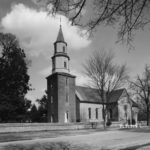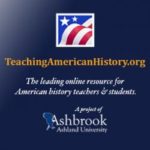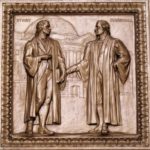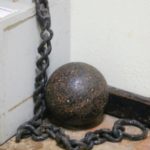Students who listen to this Grade 2 Core Knowledge History and Geography unit discover that Americans had a difficult task at hand after winning the Revolutionary War: they had to figure out a better way to govern themselves. Such leaders as James Madison, George Washington, Alexander Hamilton, and Benjamin Franklin traveled to Philadelphia to meet at the Constitutional Convention, with the goal of creating a new government. Students learn that the talks were held in secret in Independence Hall and that American leaders argued about many issues until they agreed to approve a new Constitution. They then hear that James Madison (whom we call the Father of the Constitution), along with John Jay and Alexander Hamilton, wrote the Federalist Papers to explain the document’s merits and to persuade the states to vote for it. Students find out that the states did finally approve the Constitution; that Madison wrote a Bill of Rights that was added to it; that the Constitution gives the American people the right to decide what the laws should be for our country; and that we can still amend it today.(5 lessons)
A Deep Stain on the American Character: John Marshall and Justice for Native Americans
In this lesson, students will learn about the actions of John Marshall concerning the Cherokee nation. They will explore how his actions helped to advance justice and, through his example, learn how they can advance justice in their own lives.
Slavery and the American Founding: The “Inconsistency Not to Be Excused”
Religion in Colonial America

This short video examines impact of Reformed Christianity on the minds and hearts of the Framers of the Constitution. Influenced by the writings of John Locke, Algernon Sydney, and John Calvin, Founders such as George Washington and John Adams believed that religion should play an informal, though important, role in American Society. Professor Jeffry Morrison examines Adams’ contention that colonial fears of British bishops helped to inflame revolutionary sentiments.
Slavery a Positive Good, John C. Calhoun

John C. Calhoun was a U.S. statesman and spokesman for the slave-plantation system of the South. He explains in this article that slavery gives people more serious opportunities to better themselves because of slaves. This source allows students to examine the supposed justifications for slavery and challenge the assumptions made by slaveowners.
John Marshall, Marbury v. Madison and Judicial Review—How the Court Became Supreme

If James Madison was the “father” of the Constitution” John Marshall was the “father of the Supreme Court”—almost single-handedly clarifying its powers. This new lesson is designed to help students understand Marshall’s brilliant strategy in issuing his decision on Marbury v. Madison, the significance of the concept of judicial review, and the language of this watershed case.
Join the Barons!
King John has pushed your buttons and pulled your purse strings one too many times — will you join your baron brethren in the campaign for an agreement between monarch and landowners? And do you know the proper course of action? Make sure you’ve listened closely to our episode, the don your robes, dash out of your manor and find your surest footed steed — it’s time to make Magna Carta a reality. You can join the adventure here!
The 19th Amendment: Part 2 Podcast
The Nineteenth Amendment was first introduced to Congress in 1878. It took over four decades of pleas, protests, petitions and speeches to finally get it ratified. We’re told that the Nineteenth granted all women the right to vote in America — but this was not the case in practice. How did the divides in the suffrage movement define the fight for women’s enfranchisement? And how did that amendment finally get passed? With a stern note from someone’s mom.
Our guests are once again historians Martha Jones of John Hopkins University, Laura Free of Hobart and William Smith Colleges and Lisa Tetrault of Carnegie Mellon University.
This short episode includes a one-page Graphic Organizer for students to take notes on while listening, as well as discussion questions on the back side.
19th Amendment: Part 1 Podcast
The prominent figures and events of the women’s suffrage movement of the 19th and 20th centuries can feel almost mythical at times. That’s in part because they are, in fact, myths. The telling of the Nineteenth Amendment tends to stretch from a convention in Seneca Falls, New York, in 1848 to the amendment’s ratification in 1920, but the true story is a much longer one. We explore the myths and unveil the realities in part one of two episodes on the Nineteenth Amendment. Our guests are historians Martha Jones of John Hopkins University, Laura Free of Hobart and William Smith Colleges, and Lisa Tetrault of Carnegie Mellon University.
This short episode includes a one-page Graphic Organizer for students to take notes on while listening, as well as discussion questions on the back side.
Election of 1800
In this activity, students will analyze the Electoral College tally for the presidential election of 1800 between John Adams and Thomas Jefferson.
